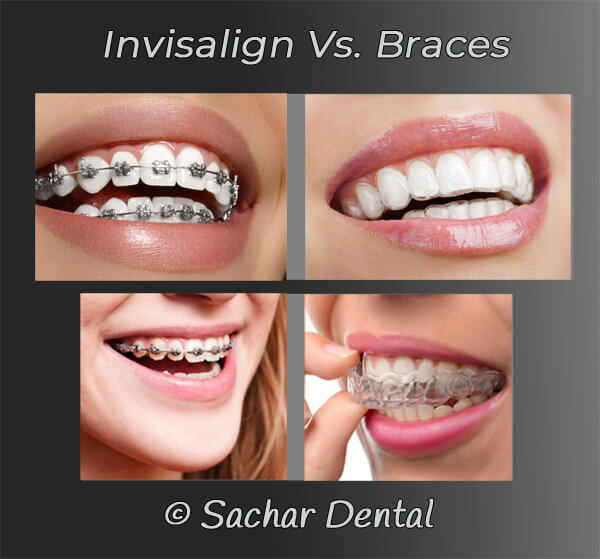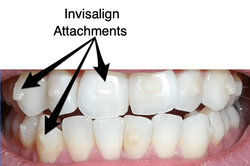The Price of Invisalign: Understanding the Investment in Your Smile
Invisalign vs. Conventional Braces: Which Alternative Is Right for You?
When considering orthodontic treatment, the selection in between Invisalign and standard braces presents a number of essential elements that merit cautious assessment. Invisalign offers a very discreet choice with removable aligners, while conventional dental braces give an extra visible yet reliable option for extreme misalignment.
Review of Treatment Choices

On the other hand, typical braces include metal brackets and cords that are bound to the teeth. This approach uses constant pressure with time to accomplish positioning. While effective for intricate orthodontic concerns, traditional dental braces call for normal gos to for changes and can pose challenges in maintaining oral health because of the difficulty of cleaning around braces and wires.
Both choices have their merits, and the choice commonly hinges on particular oral problems, way of living preferences, and person conformity. Inevitably, seeking advice from an orthodontic professional is important for determining one of the most appropriate treatment strategy customized to private requirements. Understanding the subtleties of each choice can substantially affect the general success of orthodontic therapy.
Visual Factors To Consider
A significant variable affecting the selection between Invisalign and typical dental braces is the visual appeal each treatment provides. Invisalign aligners are crafted from clear plastic, making them essentially unnoticeable when used. This very discreet look is specifically interesting adults and young adults who may really feel awkward about their orthodontic treatment. The capability to preserve an all-natural smile throughout the alignment procedure can significantly improve the patient's self-confidence in specialist and social settings.
On the other hand, conventional dental braces include metal brackets and cables, which can be extra noticeable. While developments in orthodontic modern technology have actually caused the development of smaller sized braces and tinted elastics, conventional braces still keep a more conspicuous profile. For some people, the exposure of dental braces may hinder them from seeking necessary therapy.
Eventually, the option in between Invisalign and typical braces might pivot on personal preferences regarding aesthetics. People who prioritize discretion commonly lean towards Invisalign, while those that are less worried regarding visibility might choose for standard braces. Understanding the visual effects of each option is important for making a notified decision that aligns with one's way of living and choices.
Comfort and Convenience

In regards to convenience, Invisalign aligners are detachable, allowing people to enjoy their favorite foods without restriction and keep optimal oral health. Cleaning and flossing are simplified, as the aligners can be secured throughout these routines, whereas standard dental braces call for mindful navigating around wires and braces.
Furthermore, Invisalign's modern system enables for fewer orthodontic sees. Individuals generally receive multiple collections of aligners at as soon as, which can enhance the treatment process and lower time invested in the orthodontist's chair. On the other hand, conventional braces necessitate routine modifications, making them much less hassle-free for those with active routines. Invisalign. Generally, the convenience and convenience of Invisalign make it an attractive selection for many individuals seeking orthodontic treatment.
Treatment Period and Effectiveness
While both Invisalign and typical dental braces are reliable in dealing with oral misalignments, the duration of treatment can vary substantially between the 2 options. Normally, Invisalign therapy can take anywhere from 12 to 18 months, relying on the intricacy of the case. The clear aligners work by progressively shifting teeth right into their desired placements, and normal follow-ups with an orthodontist assistance ensure progression stays on track.
On the other hand, traditional dental braces commonly call for a longer commitment, normally varying from 18 months to 3 years. This is because of their fixed nature and using brackets and cables, which can be a lot more effective for complicated cases and severe imbalances (Invisalign). The therapy efficiency of traditional braces is well-documented, as they enable for accurate changes and better control over tooth movement
Eventually, the choice in between Invisalign and standard braces may hinge on both the awaited therapy duration and the specific oral concerns at hand. Consulting with an orthodontist visit our website is critical, as they can supply tailored referrals based upon specific demands, guaranteeing the picked approach lines up with wanted durations and results.
Cost Contrast and Insurance Policy Alternatives
Price plays a considerable duty in the decision-making procedure for individuals taking into consideration orthodontic therapy, whether going with Invisalign or traditional dental braces. Typically, the cost of Invisalign ranges from $3,000 to $8,000, next page while typical dental braces normally set you back in between $2,000 and $6,000. Elements affecting these expenses consist of the intricacy of the situation, the period of therapy, and geographical location.
Lots of dental insurance strategies offer partial coverage for orthodontic therapies, but the specifics can differ extensively. Typically, standard braces may be extra often covered by insurance policy plans compared to Invisalign, which some insurers categorize as an aesthetic procedure.
Furthermore, several orthodontic methods use versatile payment strategies, making both therapy choices extra obtainable. Individuals should inquire concerning potential financing alternatives and discount rates for upfront repayments. Examining the overall cost, including insurance policy benefits and layaway plan, is essential for making an informed decision that lines up with both visual choices and budget considerations.

Final Thought
In recap, the selection between Invisalign and traditional dental braces hinges on multiple factors, including visual preferences, comfort, therapy period, and expense. Invisalign offers a very discreet, removable choice that assists in dental hygiene and nutritional adaptability, while traditional dental braces might be much more suitable for complex oral problems and typically come at a reduced price point. Ultimately, appointment with an orthodontist is necessary to evaluate individual conditions and establish one of the most suitable therapy alternative for accomplishing ideal dental placement.
When thinking about orthodontic therapy, the selection in between Invisalign and standard braces offers a number of crucial aspects that warrant mindful examination.Contrasting Invisalign and typical braces reveals distinct therapy alternatives for orthodontic adjustment.While both Invisalign and traditional dental braces are effective in remedying oral imbalances, the duration of therapy can vary significantly in between the two options.Price plays a considerable role in the decision-making procedure for people thinking about orthodontic treatment, whether opting for Invisalign or traditional dental braces.In summary, the choice in between Invisalign and typical braces pivots on numerous factors, including visual preferences, convenience, therapy duration, and price.